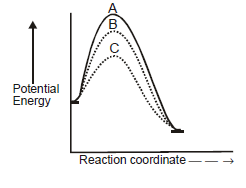Surface Chemistry (Chapter Test - Non-Medical) - Class 12 MCQ
20 Questions MCQ Test - Surface Chemistry (Chapter Test - Non-Medical)
Plot of log (x/m) against log P is a straight line inclined at an angle of 450. When the pressure is 0.5 atm and
Freundich parameter, k is 10, the amount of solute adsorbed per gram of adsorbent will be: (log 5 = 0.6990).
Freundich parameter, k is 10, the amount of solute adsorbed per gram of adsorbent will be: (log 5 = 0.6990).
Which of the following factors are responsible for the increase in the rate of a surface catalysed reaction?
(i) A catalyst provides proper orientation for the reactant molecules to react.
(ii) Heat of adsorption of reactants on a catalyst helps reactant molecules to overcome activation energy.
(iii) The catalyst increase the activation energy of the reaction.
(iv) Adsorption increases the local concentration of reactant molecules on the surface of the catalyst.
Select the correct answer using the codes given below:
(ii) Heat of adsorption of reactants on a catalyst helps reactant molecules to overcome activation energy.
(iii) The catalyst increase the activation energy of the reaction.
(iv) Adsorption increases the local concentration of reactant molecules on the surface of the catalyst.
| 1 Crore+ students have signed up on EduRev. Have you? Download the App |
In homogeneous catalytic reactions, there are three alternative paths A, B and C (show in the figure). Which
one of the following indicates the relative case with which the reaction can take place?

one of the following indicates the relative case with which the reaction can take place?
In presence of catalyst, the activation energy is lowered by 3 kcal at 270C. Hence, the rate of reaction will increase
by
Graph between log x and log (x/m) is straight line at angle of 450 with the intercept of 0.6020
The extent of adsorption (x/m) at a pressure of 1 atm is
In the reaction of autocatalysis,the variation of concentration with time is correctly represented by which
of the following plots ?
For adsorption of a gas on solid, the plot of log x/m vs log p is linear with slope equal to (n being whole number)
Of the following statements about enzymes, which one is true ?
(i) Enzymes lack in nucleophilic group.
(ii) Enzymes are highly specific both in binding chiral substrates and in catalysing their reactions.
(iii) Enzymes catalyse chemical reactions by lowering the activation energy.
(iv) Pepsin is a proteolytic enzyme.
Which of the following statements is not correct ?
One litre vessel having 20 g charcoal (density 2.0 g/cm3) was filled with a gas at 300 K. The pressure of a
gas was 760 torr. Due to adsorption the pressure of gas falls to 608 torr. What is the number of gas molecule
adsorbed per g of charcoal ?
According to the adsortion theory of catalysis, the speed of the reaction increases because
Which of the following represents correctly, the variation of degree of adsorption against temperature, for physi
adsorption ?
The coagulating power of electrolytes having ions Na+, Al3+ and Ba2+ for arsenic sulphide sol increases in the
order
Under ambient conditions, which among the following surfactants will form micelles in aqueous solution at
lowest molar concentration ?
The type of emulsion is mentioned against the emulsion in each of the following. Which is not correctly
matched ?
Bleeding is stopped by the application of ferric chloride. This is because
A white precipitates of Sn(OH)4 is peptized with dilution HCl. The solution particle will carry
Which of the following metal solutions cannot be prepared by Bredig’s arc method ?
Comprehension Based Questions
The adsorption is called physical adsorption or physiosorption if the accumulation of gas on the surface of a solid occurs due to weak van der Waals forces. The adsorption is called chemical adsorption or chemisorption when the gas molecules or atoms are held to the solid surface by chemical bonds that are either ionic or covalent. Chemisorption is often referred to as activated adsorption because it has a rather high energy of activation.
Q.
Which of the following is not a characteristic of chemisorption ?
Equilibrium in chemisorption attained

















